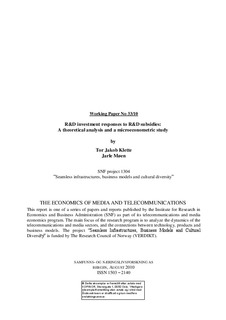| dc.description.abstract | Whereas many countries subsidize R&D in private companies through tax credits, subsidies to the Norwegian high-tech industries have traditionally been given as matching grants, i.e. the subsidies are targeted, and the firms have to contribute a 50 percent own risk capital to the subsidized projects. Our results suggest that grants do not crowd out privately financed R&D, but that subsidized firms do not increase their privately financed R&D either. Hence, the own risk capital seems to be taken from ordinary R&D budgets. We also investigate possible long-run effects of R&D subsidies, and show that conventional R&D investment models predict negative dynamic effects of subsidies. Our data, however, do not support this claim. On the contrary, there seem to be positive dynamic effects, i.e. temporary R&D subsidies seem to stimulate firms to increase their R&D investments even after the grants have expired. We propose learning-by-doing in R&D activities as a possible explanation for this, and present a theoretical analysis showing that such effects may alter the predictions of the conventional models. A structural, econometric model of R&D investments incorporating such learning effects is estimated with reasonable results. | en |
